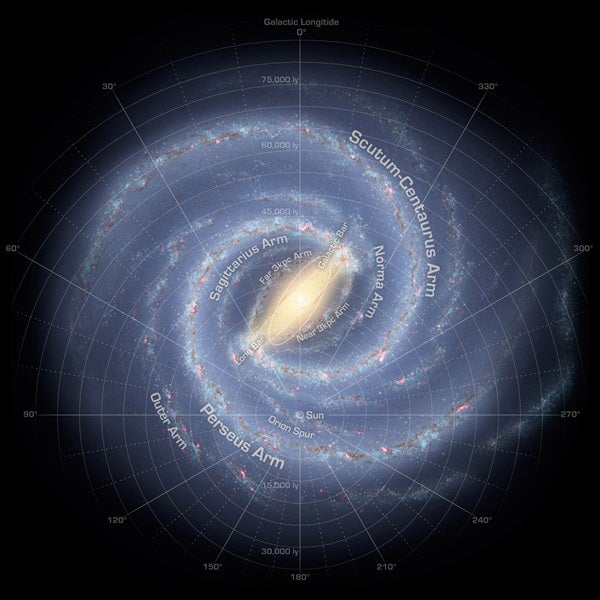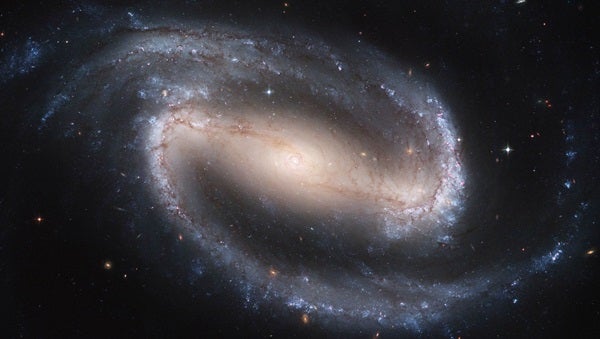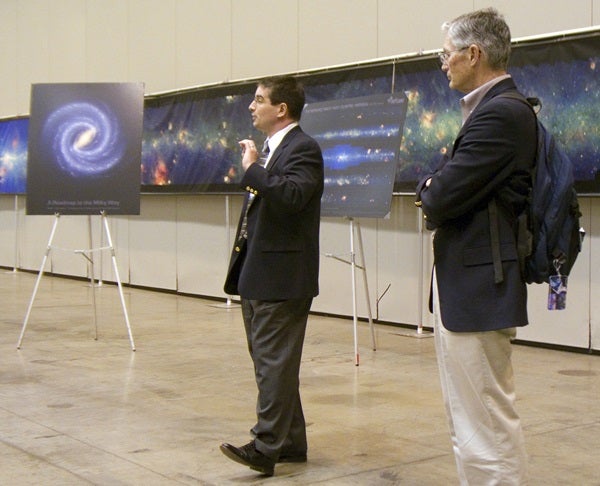Teams of astronomers studying the Milky Way using infrared and radio waves presented an updated view of our galaxy’s structure June 3 at the American Astronomical Society meeting in St. Louis. Among the findings is the discovery of a long suspected inner spiral arm and recognition that the Milky Way contains two main arms, rather than four.
Mapping the Milky Way has a long and checkered history. The first attempt, by William Herschel in 1785, used a straightforward method he called “star gauging.” He reasoned that the galaxy was uniformly filled with stars out to its edge. If so, then the distance to this edge could be found by counting the number of stars seen in different directions.
Herschel visually counted stars in more than 600 directions, but his model came up short because dust in the galaxy’s plane obscures the light of distant stars. At visual wavelengths, explains Mark Reid at the Harvard-Smithsonian Center for Astrophysics in Cambridge, Massachusetts, mapping galactic structure beyond about 6,000 light-years is just about impossible.
More than two centuries later, another star-count project revealed the Milky Way as a spiral galaxy. In 1951, William Morgan of Yerkes Observatory mapped hot, young, O-type stars, and found they traced three arcs in the galaxy’s disk. He took these to be spiral arms, and named them for their associated constellations: Perseus, Orion, and Sagittarius.
Later radio surveys, which mapped gas in the galactic plane, solidified and extended the picture of the Milky Way as a spiral galaxy with four prominent arms called Norma, Scutum-Centaurus, Sagittarius, and Perseus. The Orion arm Morgan identified is now called the Orion Spur, a patch of gas and dust located between the Sagittarius and Perseus arms. This is where the Sun resides.
“Mapping the spiral arms is really hard,” says Robert Benjamin at the University of Wisconsin-Whitewater. “For years, people created maps of the whole galaxy based on studying just one section of it, or using only one method. Unfortunately, when the models from various groups were compared, they didn’t always agree. It’s a bit like studying an elephant blindfolded.”
Because the galaxy is transparent at infrared wavelengths, Benjamin and his colleagues applied the star-count idea to survey data from NASA’s heat-sensitive Spitzer Space Telescope. The survey, called the Galactic Legacy Infrared Mid-Plane Survey Extraordinaire (GLIMPSE), includes more than 100 million stars along a 130° swath of the sky.
The astronomers measured the density of stars across GLIMPSE and readily detected an overdensity in the direction of the Scutum-Centaurus arm. But they saw no corresponding jump in the number of stars associated with the expected locations of the Sagittarius and Norma arms. (The Perseus arm lies beyond the region GLIMPSE mapped.)
In 2005, Benjamin used GLIMPSE data to show that the Milky Way sports a prominent stellar bar at its center, confirming findings from earlier surveys that our galaxy would be classified as a barred spiral if seen from the outside. The new findings indicate the Milky Way has two major spiral arms, a common appearance for barred spirals, which often display prominent arms linked to the bar’s ends.
The Scutum-Centaurus and Perseus arms, which have the greatest densities of both young, bright stars and older red giants, fit the bill. The Sagittarius and Norma arms, however, appear to be minor features formed by patches of gas and pockets of young stars.
Benjamin emphasizes the new view is just a starting point for a Milky Way makeover. Among other problems, the “long bar” evident in GLIMPSE data doesn’t align with the smaller central bar identified in earlier infrared studies. “That’s something we have yet to resolve,” he says.
Other research resolves a longstanding puzzle about the Milky Way’s inner structure. Fifty years ago, radio astronomers found an unusual spiral arm about 10,000 light-years from the center of the Milky Way along our line of sight. The arm contains about 10 million Sun’s worth of hydrogen gas and, oddly, appeared to be expanding toward us at more than 118,000 mph (190,000 km/h). Astronomers dubbed it the expanding 3-kiloparsec arm.
Because most spiral galaxies tend to be symmetrical, astronomers suspected a similar arm might exist on the far side of the Milky Way. But they failed to find a far-side counterpart to the expanding 3-kiloparsec arm.
Tom Dame and Patrick Thaddeus at the Harvard-Smithsonian Center for Astrophysics analyzed radio maps of galactic gas obtained at the Cerro Tololo Inter-American Observatory in Chile. When Dame processed the data to highlight large-scale structures close to the galactic plane, a new feature jumped out at him. The data clearly show a spiral arm right where a far-side 3-kiloparsec arm should be. Radio observations of atomic hydrogen collected by colleagues in Australia allowed the astronomers to confirm the finding. “In our data, everything we can measure about these two arms is very similar,” Dame says.
The astronomers suspect the 3-kiloparsec arms form as a result of gas interaction with the galaxy’s big stellar bar, which contains billions of stars and extends for several thousand light-years on either side of the galactic center. As the bar rotates, it produces large-scale shock waves that likely sculpt the arms and power their outward motions.
A detailed look at the positions and velocities of star-forming regions shows that these areas orbit the galaxy more slowly than expected. “Almost all of our targets seem to have been accelerated opposite the direction of the galaxy’s rotation,” says Mark Reid.
Reid and his colleagues used the Very Long Baseline Array (VLBA), a network of 10 radio telescopes which, when combined, achieves the highest angular resolution in astronomy. He measured the parallax to star-forming regions, which provides a “gold standard” distance based on geometry, and obtained data on their motion through space.
Reid speculates these regions appear to be slowed because they interact with the density waves that create the galaxy’s spiral arms. Gas clouds approaching a spiral arm catch up to each other and slow down. They also compress, which triggers the formation of hot, young stars. The slow-down makes the regions’ paths around the galaxy more elliptical than the idealized circular orbits astronomers assumed.
The team plans to continue this mapping project to answer basic questions about the galactic structure. “Right now, our map of the Milky Way still has large areas marked ‘Here there be dragons.’ Ten years from now, those areas will be filled in,” Reid says.












